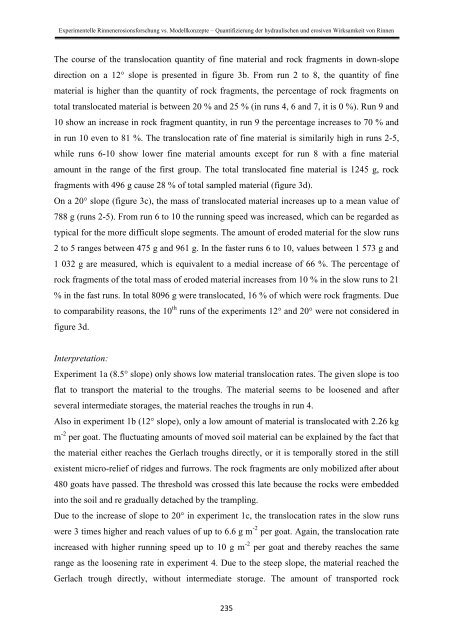Stefan Wirtz Vom Fachbereich VI (Geographie/Geowissenschaften ...
Stefan Wirtz Vom Fachbereich VI (Geographie/Geowissenschaften ...
Stefan Wirtz Vom Fachbereich VI (Geographie/Geowissenschaften ...
Create successful ePaper yourself
Turn your PDF publications into a flip-book with our unique Google optimized e-Paper software.
Experimentelle Rinnenerosionsforschung vs. Modellkonzepte – Quantifizierung der hydraulischen und erosiven Wirksamkeit von Rinnen<br />
The course of the translocation quantity of fine material and rock fragments in down-slope<br />
direction on a 12° slope is presented in figure 3b. From run 2 to 8, the quantity of fine<br />
material is higher than the quantity of rock fragments, the percentage of rock fragments on<br />
total translocated material is between 20 % and 25 % (in runs 4, 6 and 7, it is 0 %). Run 9 and<br />
10 show an increase in rock fragment quantity, in run 9 the percentage increases to 70 % and<br />
in run 10 even to 81 %. The translocation rate of fine material is similarily high in runs 2-5,<br />
while runs 6-10 show lower fine material amounts except for run 8 with a fine material<br />
amount in the range of the first group. The total translocated fine material is 1245 g, rock<br />
fragments with 496 g cause 28 % of total sampled material (figure 3d).<br />
On a 20° slope (figure 3c), the mass of translocated material increases up to a mean value of<br />
788 g (runs 2-5). From run 6 to 10 the running speed was increased, which can be regarded as<br />
typical for the more difficult slope segments. The amount of eroded material for the slow runs<br />
2 to 5 ranges between 475 g and 961 g. In the faster runs 6 to 10, values between 1 573 g and<br />
1 032 g are measured, which is equivalent to a medial increase of 66 %. The percentage of<br />
rock fragments of the total mass of eroded material increases from 10 % in the slow runs to 21<br />
% in the fast runs. In total 8096 g were translocated, 16 % of which were rock fragments. Due<br />
to comparability reasons, the 10 th runs of the experiments 12° and 20° were not considered in<br />
figure 3d.<br />
Interpretation:<br />
Experiment 1a (8.5° slope) only shows low material translocation rates. The given slope is too<br />
flat to transport the material to the troughs. The material seems to be loosened and after<br />
several intermediate storages, the material reaches the troughs in run 4.<br />
Also in experiment 1b (12° slope), only a low amount of material is translocated with 2.26 kg<br />
m -2 per goat. The fluctuating amounts of moved soil material can be explained by the fact that<br />
the material either reaches the Gerlach troughs directly, or it is temporally stored in the still<br />
existent micro-relief of ridges and furrows. The rock fragments are only mobilized after about<br />
480 goats have passed. The threshold was crossed this late because the rocks were embedded<br />
into the soil and re gradually detached by the trampling.<br />
Due to the increase of slope to 20° in experiment 1c, the translocation rates in the slow runs<br />
were 3 times higher and reach values of up to 6.6 g m -2 per goat. Again, the translocation rate<br />
increased with higher running speed up to 10 g m -2 per goat and thereby reaches the same<br />
range as the loosening rate in experiment 4. Due to the steep slope, the material reached the<br />
Gerlach trough directly, without intermediate storage. The amount of transported rock<br />
235
















